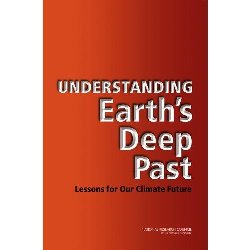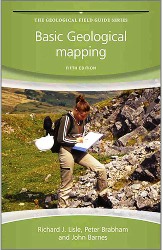 Igneous Rocks and Processes
Igneous Rocks and Processes
It’s a tough call to produce an igneous petrology book that engages the readers and draws them on, but it’s hard to imagine a better attempt than this by Robin Gill. Although the cover blurb suggests use for “introductory or intermediate-level courses in igneous petrology” I reckon first-year students would find much of it hard going, whereas third and fourth-year undergraduates would find it an invaluable source of support.
This is avowedly not a book on field relations, though there is a physical volcanology chapter that covers eruption styles comprehensively enough. Another digression is an early chapter covering experimental petrology that also teaches the use of binary and ternary phase diagrams.
Apart from those and a highly-readable introductory chapter, the text works its way systematically through each broad class of igneous rocks (basalts and related; gabbroic; ultramafic and ultrabasic; andesite-dacite-rhyolite; granitic; alkali) with the emphasis on identifying each by normative and modal mineralogy, texture, and geochemical fingerprinting. Competing models of magmagenesis and fractionation are met head on and discussed, with multiple references to the recent literature. The tangled web of igneous rock names is negotiated sympathetically, distinguishing between categories that seem to have genuine petrogenetic significance, and those that are arbitrary divisions within a continuum.
The tectonic settings where rocks of each type may be found are discussed, but (rightly) not treated as an aspect of the diagnostic process. Appendices describe various means of identifying igneous minerals with a petrological microscope, and how to do petrographic calculations. The text is supported by boxes, and exercises (with answers) so that conscientious students can consolidate their learning.
It’s a shame to find a book of this quality illustrated in black and white, apart from a colour plate section. However, most of the photographs are available in colour on the associated website. The appendices are supported online too, although the worksheet for calculating normative mineralogy would have been more useful as a functioning spreadsheet rather than as a pdf template.
If I wanted to nit-pick I would point out that, contrary to an assertion on page 24, there are places where a’a lava reverts (downflow) to pahoehoe. But that would be too churlish; so instead I will end by complementing Robin Gill on his fine treatment of carbonatites, a fascinating suite of volcanic rocks that even Sugurdsson’s much-vaunted Encyclopedia of Volcanoes (2000) managed to overlook.
Reviewed by David A Rothery
IGNEOUS ROCKS AND PROCESSES: A PRACTICAL GUIDE ROBIN GILL, Published by Wiley-Blackwell 2010 ISBN 978-1444330656 hbk 440pp List Price: £90.00 (hbk) £37.50 (pbk) http://eu.wiley.com
 The Geology of Barcelona
The Geology of Barcelona
This guide seeks to describe the geology and scenery of Barcelona and amply succeeds. The authors, both residents of the city, accomplish the difficult task of combining a general landscape appraisal with sufficient technical detail, at points visited, to satisfy both the keen amateur and professional geologist.
Following a brief touristic introduction to the main websites for geology, travel and hotels in the Catalonian capital, the regional geological setting is explained succinctly with clear schematic maps and a section. An overview of the literature sets the historical context of geological research, which is also covered by an extensive bibliography. Most of the literature is in Spanish and Catalan until the last decade. This literature summary interrupts the flow from the geological introduction to the lengthier (seven-page) stratigraphic and paleogeographic overview; it would have been better located with the bibliography.
Excursions are the key to the success of this book. Three field trips, each a comfortable day’s walk, start on the high ground with an overview of the landscape, and in descending, encounter all the major geological units from oldest to youngest and conclude in the city’s Mediaeval and Roman heart. Each excursion combines a well designed schematic map that incorporates geology, viewpoints, stopping points that link to photographs, and essential Metro and funicular access information. Directions and descriptions in the text and photo captions link clearly with the maps. Mineral and structural details are well explained with good annotated photographs. The captions are substantial and complement the text.
Excursion one begins by funicular to the Collserola Hills, high above Barcelona. This seven to eight kilometre traverse of Palaeozoic metamorphic and Permian granitic terrains has panoramic views of the geological structure and Barcelona. Excursion two, six kilometres in length, picks up where the first ends, crossing a thrust zone with complex faulting, well illustrated in photographs and sections. Excursion three covers the Pleistocene coastal strip and Barcelona’s core. As in situ geology is obscured, this ramble focuses on locally quarried masonry, historic seismicity and fluvial geomorphology.
This book carries a useful glossary; its production design and quality are excellent, its layout clear, the text efficiently proofed. Its authors have successfully balanced local detail within a general overview. Through its descriptions, maps and photographs, this guide provides informative excursions for the mind’s eye and is a strong enticement to visit - or revisit – this beautiful city.
Reviewed by John Henry
THE GEOLOGY OF BARCELONA: AN URBAN EXCURSION GUIDE WES GIBBONS & TERESA MORENO GA Guide No 70, Geologists’ Association, 2012. ISBN 978 0900717 56 7List price £12.00 www.geologistsassociation.org.uk/GAGuideSales.html
 Understanding Earth’s Deep Past
Understanding Earth’s Deep Past
In the last few years there has been a lot of talk about global warming caused by anthropogenic CO2 and so it is refreshing to read a book considering the warming events that have occurred naturally in the deep geological past, and how long they have lasted. As well as warming, increase in CO2 has had a number of other effects on Earth’s systems.
We are in a generally cool (‘icehouse’) condition at present; but most of earth’s history has been spent in its warmer (‘greenhouse’) condition. Understanding the transitions between these two states is important and is given prominence in this discussion.
The book is an excellent survey of research in this field, and of what further work needs to be done. However, much of the modelling described and predictions made are based on 20th and 21st Century data, and are therefore somewhat limited. Much of the book is a plea for further computational resources, although it does acknowledge the limitations of such work. It looks at what needs to be known and uses proxies, (for CO2 concentration, for example) in an attempt to achieve more.
It talks not only of the research agenda but the strategies and tools required to implement it. It discusses the resource requirement; the education and outreach needed to the general public, who are presently barraged with information about global warming but who at present have limited understanding. Also discussed are the policymakers and their understanding of the data on which they base their policies.
The greenhouse/icehouse fluctuation in Earth climate remains one of the least understood aspects of Earth history. This book gives an excellent overview of thinking on climate change, both past and present and it is a very useful introduction to the subject. It is surprisingly well-written, in an interesting and easy-reading style with many clear and informative diagrams that support the text well. With a fine binding and blessed with high production values it constitutes outstanding value at £23.00.
Reviewed by Steve Rowlatt
UNDERSTANDING EARTH’S DEEP PAST. LESSONS FOR OUR CLIMATE FUTURE. NATIONAL RESEARCH COUNCIL, Published by National Academies Press 2011 ISBN: 978-0-309-20915-1 pbk 194pp List price: £23.00 www.nap.edu
 Basic Geological mapping
Basic Geological mapping
Death, taxes and - if you have ever been a geology undergraduate - a mapping dissertation, are unavoidable trials we have all faced. What saved me in the field years ago was an earlier edition of this book, and I was heartened to see that the same logical layout and clear, no-nonsense text has been adopted for this fifth edition.
This invaluable volume is a ideal accompaniment to planning and executing an undergraduate mapping project and the subsequent production of fair-copy maps. Comprehensive lists of matériel for all likely climates, advice on compass clinometers, hammers and chisels are all there, as would be expected. Especially useful though are the suggestions on how to construct field notes that will actually mean something when you return! If these are read before embarking on a mapping project, your chances of success (of producing a map that makes geological sense) can only be improved. The level of assumed prior knowledge is reassuringly low, as demonstrated by comprehensive descriptions of how to take basic field measurements, and even instructions for (when that moment of blind panic sets in) how to use your compass - Silva, prismatic or otherwise.
Illustrated with scores of clear figures and photos, with informative captions, an undergraduate mapper (or a rusty one, returning to the field) would be hard pressed to find a more user-friendly guide to the craft. The section on technological aids is somewhat redundant for most undergraduate mapping projects and, for me, does not add enormously to its value. However as the nature of mapping changes I suspect this section will become more and more relevant and will grow in subsequent editions; though hopefully not at the expense of the lavishly detailed classical techniques.
Although this handy pocket volume will never wholly substitute for a course of lectures and practicals, and will not give the same reassurance as having one’s own dissertation supervisor on hand in the field, it is probably the next best thing. Mine got me out of a few uncertain moments in the field, and I’m sure this edition will do likewise for today’s budding geologists. As a pallid geochemist now, it almost makes me want to dust off my compass clinometer. Almost.
Reviewed by Jason Harvey
BASIC GEOLOGICAL MAPPING (5th Edn.) RICHARD LISLE, PETER BRABHAM AND JOHN BARNES. Published by Wiley-Blackwell 2011 ISBN 978-0-470-68634-8 217pp. List price £22.50. www.wiley.com/wiley-blackwell